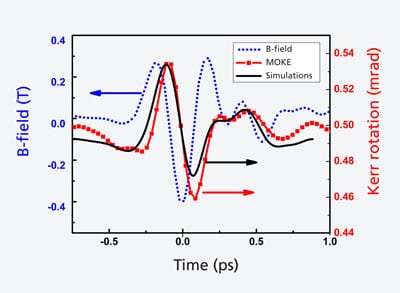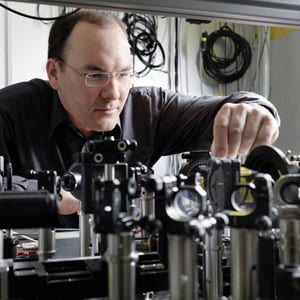An enormously strong terahertz laser makes it possible to control a material’s magnetisation at a timescale of picoseconds. In their experiment, researchers from Paul Scherrer Institute of Switzerland and colleagues at the Université Pierre et Marie Curie in Paris fired extremely short light pulses from the laser onto a magnetic material, and by doing so, aligned its “elementary magnets” in parallel. The light pulse’s magnetic field was able to deflect the magnetic moments from their idle state in such a way that they exactly followed the change of the laser’s magnetic field with only a minor delay. One special feature is the fact that it is phase-stable, which enables the exact change in the electrical and magnetic field within the individual pulses to be defined reliably for each laser pulse. As the majority of data is stored magnetically these days, the possibility to quickly change a material’s magnetisation is crucial for new, rapid storage systems.

A pulse from a terahertz laser (blue) controls the magnetisation of a material: the magnetisation (red – determined via the magneto-optic Kerr effect MOKE) follows the laser pulse’s magnetic field with a slight delay. The black curve shows the prediction of a computer simulation. Source: PSI
In their experiment, the researchers used extremely short “flashes” of terahertz light. Unlike the light from conventional lasers, terahertz light does not heat up the magnetic sample, which turns out to be essential for an exact manipulation of the magnetisation. The terahertz flashes used were so short that the magnetic field just about had time to point in one direction, then in the other. In the illuminated material, the magnetic moments were deflected as a result: first in one direction, then in the other. They thus followed the change of the magnetic field in the terahertz flash exactly with a tiny delay.
Although coming from one of the strongest lasers in the world, the used laser flash is not yet intensive enough to be able to flip over the magnetisation completely; you can merely observe the dynamics, i.e. the movement of the magnetisation. The experiment, however, is described as a milestone for demonstrating the concept of the ultrafast and exact manipulation of magnetism with a laser. However, Christoph Hauri, head of the PSI laser group and professor at EPFL, is confident that a complete flip-over of the magnetism can be achieved. “There are tricks to enhance the fields of a weak laser to such an extent that they could switch the magnetisation.” This would also involve selecting a special pulse form and generating a pulse where the magnetic field initially points in one direction weakly, then strongly in the other, then point back in the original direction weakly again. If only the middle strong part of the pulse is strong enough to flip over the magnetisation, one could use such pulses to re-magnetise materials. Such precisely defined pulses are now available at the PSI.
Here, the development of the terahertz laser is part of the SwissFEL project, where the free electron x-ray laser is being constructed as the PSI’s new large-scale facility. It will produce laser light on an x-ray scale and thus make many processes visible in the material that are not accessible using today’s study methods. Terahertz lasers are due to be used in two places there. On the one hand, they will be employed for measuring the properties of the x-ray beam in operation. On the other hand, they could be used to initiate reactions in experiments where the intermediate state is to be determined later with the x-ray laser.
Source: PSI

















